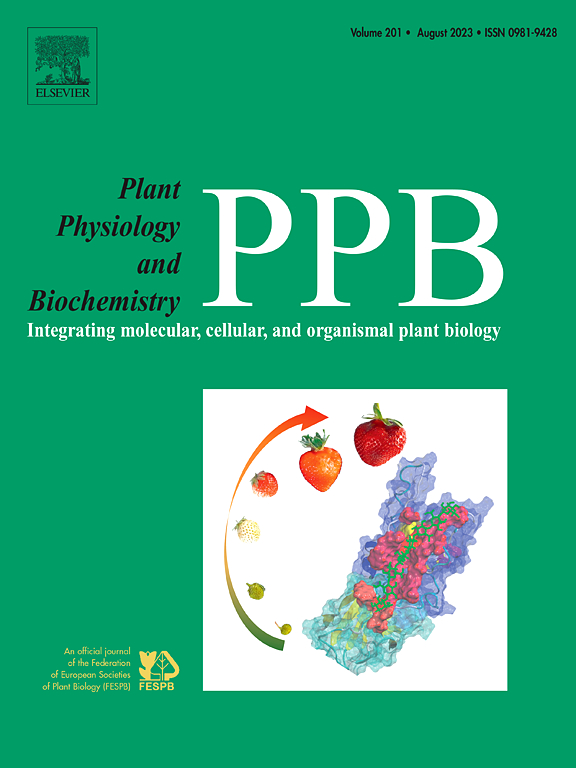稳定同位素辅助代谢组学能够研究(a)小麦中酪氨酸与苯丙氨酸的生物胁迫相关代谢
IF 5.7
2区 生物学
Q1 PLANT SCIENCES
引用次数: 0
摘要
为了研究以前很少研究的酪氨酸(Tyr)的作用,我们使用稳定同位素辅助代谢组学将其代谢与研究得很好的小麦苯丙氨酸(Phe)进行了比较。在对照和胁迫条件下(每穗添加0.2 mg镰刀菌毒素和毒力因子脱氧雪腐镰刀菌醇),用13c9 -苯丙氨酸或13c9 -酪氨酸作为代谢示踪剂处理开花小麦穗。总共检测到115种苯丙氨酸和酪氨酸衍生的小麦代谢物。对于13C9-Tyr,最初应用的示踪剂(每种0.5 mg)的总体摄取和代谢约为40%,而Phe为80%,两种示踪剂之间共有48种下游代谢物。检测到的代谢产物中约有三分之一被DON处理(DON+)显著诱导。这些化合物属于羟基肉桂酸(hca)、hca酰胺、-糖苷、-醌和木脂素类,表明它们是细胞壁加固和抗真菌化合物的前体。对13C同位素信号的评估表明,Tyr被纳入常见下游代谢物的速率约为Phe的1/6 (mock)和1/4 (DON)。与对照相比,DON胁迫诱导了Tyr的掺入,而Phe的中位掺入率没有变化。本研究强调了在同位素辅助代谢组学中使用标记的Tyr和Phe作为示踪剂的附加价值和互补性,以提高注释可信度和植物对胁迫代谢反应的生物学解释。本文章由计算机程序翻译,如有差异,请以英文原文为准。
Stable-isotope-assisted metabolomics enables the study of (a)biotic stress-related metabolism of tyrosine compared to phenylalanine in wheat
To investigate the role of the previously little-studied tyrosine (Tyr), we have used stable isotope-assisted metabolomics to compare its metabolism to the well-studied phenylalanine (Phe) in wheat. Flowering wheat ears were treated either with 13C9-Phe or 13C9-Tyr as metabolic tracers under both control and stress conditions (addition of 0.2 mg per ear of the Fusarium mycotoxin and virulence factor deoxynivalenol (DON)). Overall, 115 Phe- and Tyr-derived wheat metabolites were detected. For 13C9-Tyr, the overall uptake and metabolization of the initially applied tracers (0.5 mg each) was about 40 % compared to 80 % of Phe, and 48 downstream metabolites were shared between both tracers. About one-third of the detected metabolites were found to be significantly induced by DON treatment (DON+). Those belonged to the classes of hydroxycinnamic acids (HCAs), HCA-amides, -glycosides, -quinates and lignans, suggesting their role as precursors for cell wall reinforcement and antifungal compounds. Evaluation of 13C isotopolog signals revealed that Tyr was incorporated into common downstream metabolites at a rate of approximately 1/6 (mock) and 1/4 (DON) of that compared to Phe. Tyr incorporation was induced upon DON stress compared to control conditions, whereas Phe showed indifferent median incorporation rates. This study highlights the added value and complementarity of using labeled Tyr and Phe as tracers in isotope-assisted metabolomics to improve annotation confidence and biological interpretation of plant metabolic responses to stress.
求助全文
通过发布文献求助,成功后即可免费获取论文全文。
去求助
来源期刊
CiteScore
11.10
自引率
3.10%
发文量
410
审稿时长
33 days
期刊介绍:
Plant Physiology and Biochemistry publishes original theoretical, experimental and technical contributions in the various fields of plant physiology (biochemistry, physiology, structure, genetics, plant-microbe interactions, etc.) at diverse levels of integration (molecular, subcellular, cellular, organ, whole plant, environmental). Opinions expressed in the journal are the sole responsibility of the authors and publication does not imply the editors'' agreement.
Manuscripts describing molecular-genetic and/or gene expression data that are not integrated with biochemical analysis and/or actual measurements of plant physiological processes are not suitable for PPB. Also "Omics" studies (transcriptomics, proteomics, metabolomics, etc.) reporting descriptive analysis without an element of functional validation assays, will not be considered. Similarly, applied agronomic or phytochemical studies that generate no new, fundamental insights in plant physiological and/or biochemical processes are not suitable for publication in PPB.
Plant Physiology and Biochemistry publishes several types of articles: Reviews, Papers and Short Papers. Articles for Reviews are either invited by the editor or proposed by the authors for the editor''s prior agreement. Reviews should not exceed 40 typewritten pages and Short Papers no more than approximately 8 typewritten pages. The fundamental character of Plant Physiology and Biochemistry remains that of a journal for original results.

 求助内容:
求助内容: 应助结果提醒方式:
应助结果提醒方式:


